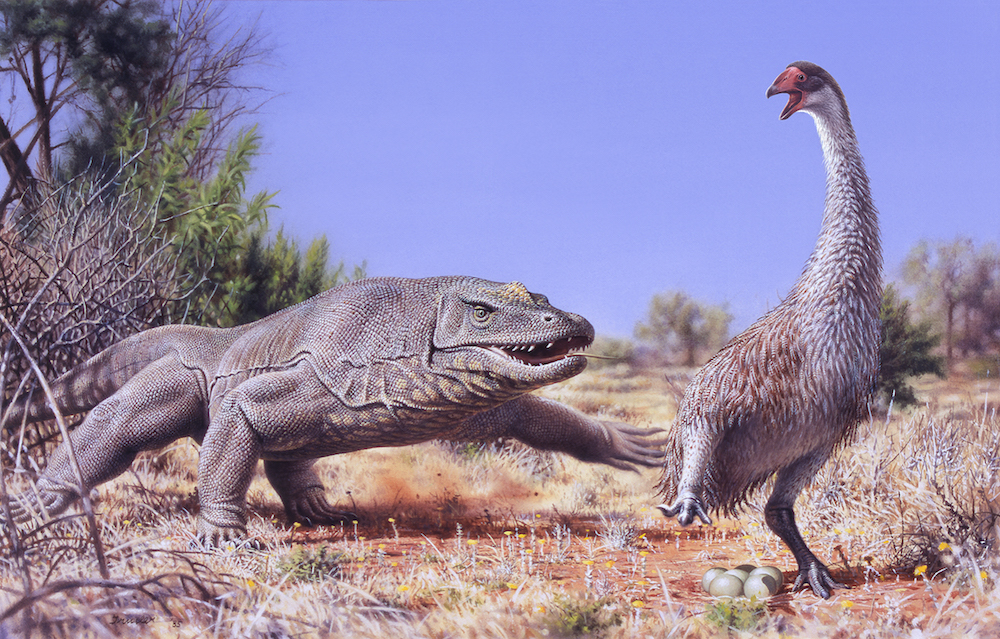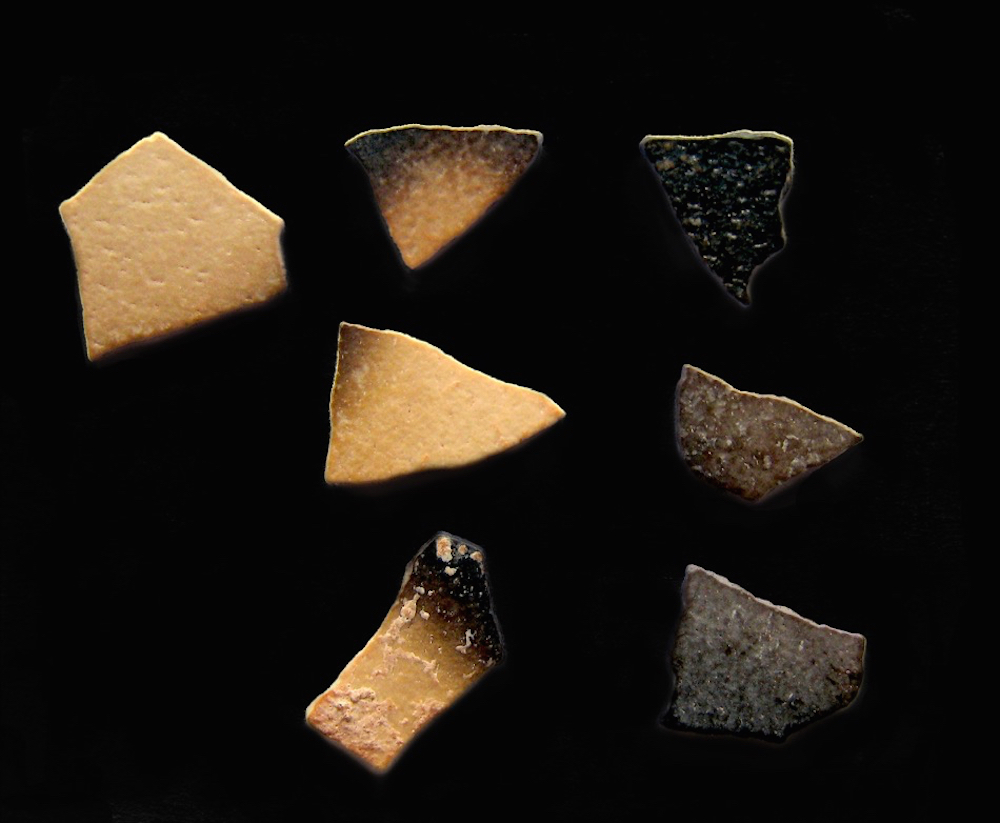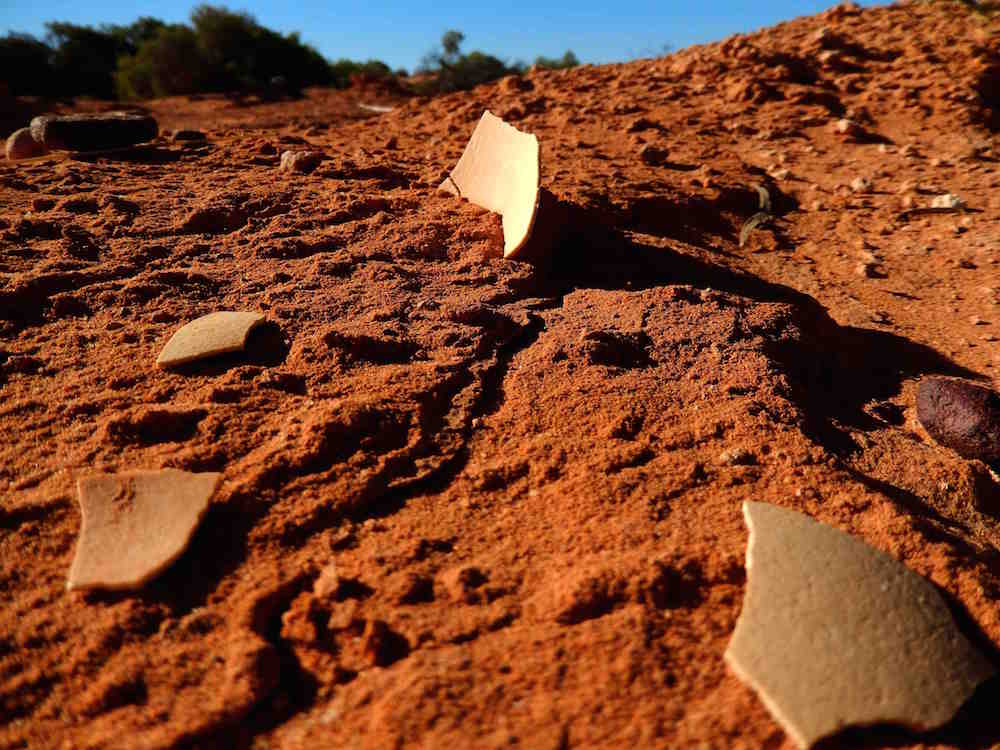Ancient Humans Ate Cantaloupe-Size Eggs from 500-Pound Birds

The burnt eggshell fragments of an ancient giant bird have helped scientists solve a 50,000-year-old whodunit in Australia.
Before humans arrived in Australia about 50,000 years ago, these flightless birds lived across much of the continent. But they mysteriously went extinct shortly thereafter. Now, evidence of human-scorched eggshells suggests that the new arrivals were cooking up the eggs for supper, likely putting a large dent in the birds' reproductive success, a new study shows. Notably, the finding supports the idea that ancient people contributed to the bird's eventual demise, the study authors said.
These weren't your average chicken eggs. The big bird, known as Genyornis newtoni, stood 7 feet tall (2.1 meters) and weighed a whopping 500 lbs. (227 kilograms). Its eggs were also enormous (about the size of cantaloupes) and weighed about 3.5 lbs. (1.6 kg). [Easter Science: 5 Odd Facts About Eggs]
"We consider this the first and only secure evidence that humans were directly preying on now-extinct Australian megafauna," Gifford Miller, a professor of geological sciences at the University of Colorado, Boulder, said in a statement. "We have documented these characteristically burned Genyornis eggshells at more than 200 sites across the continent."
Walking on eggshells
Initially, scientists were searching for and locating these eggshells to help them date ancient shorelines. But in the process of studying the shells, they found that some of them were burned and clustered together.

Over more than 20 years, they collected unburned G. newtoni eggshells from more than 2,000 sites across Australia, mostly from the sand dunes where these ancient birds nested. From 200 of the sites, they also found burned eggshells. Radiocarbon dating can date once-living organisms that lived within the past 50,000 years, but this method was difficult for these shells, as the birds lived right around that cutoff time.
Sign up for the Live Science daily newsletter now
Get the world’s most fascinating discoveries delivered straight to your inbox.
So the researchers relied mostly on optically stimulated luminescence (OSL) dating, a technique that examines when the quartz grains in the eggshells were last exposed to sunlight. OSL helped determine that the burned eggshells were between 44,000 and 54,000 years old — "the same time window that the first humans were colonizing Australia," Miller wrote in an email to Live Science.
They also relied on amino acid racemization (AAR). Amino acids, the building blocks that make up proteins, decompose in a predictable fashion over time. The burned eggshells have an interesting gradient of amino-acid decomposition within each fragment that suggests they were burned by a localized heat source, such as an ember.
The gradient does not indicate that the shells were burned by sustained high heat, such as from a wildfire, the researchers said. [10 Extinct Giants That Once Roamed North America]
The researchers suggested that the scorched eggshells were burned in transient, human-made fires, likely to cook the eggs for a prehistoric meal, Miller said.
Moreover, many of the burnt eggshells were found in clusters less than 10 feet (3 m) in diameter, with no other eggshell fragments nearby. Some of the pieces had heat gradient differences of almost 1,000 degrees Fahrenheit (538 degrees Celsius). These gradients would be almost impossible to create in a wildfire setting, Miller said.
"We can't come up with a scenario that a wildfire could produce those tremendous gradients in heat," Miller said. "We instead argue that the conditions are consistent with early humans harvesting Genyornis eggs, cooking them over fires and then randomly discarding the eggshell fragments in and around their cooking fires."
Bye, big bird

G. newtoni is hardly the only megafauna (animals weighing more than 100 lbs., or 45 kg) that lived about 50,000 years ago in Australia. There was a 1,000-lb. (450 kg) kangaroo, a 2-ton wombat, a 25-foot-long (7.6 m) lizard and a tortoise the size of a Volkswagen.
However, more than 85 percent of the continent's megafauna went extinct not long after humans arrived.
The reasons for these extinctions are hotly debated. Some scientists say humans are to blame, others credit climate change and some say it's likely a mixture of both.
But the continental drying of Australia, from about 60,000 to 40,000 years ago, is likely not the main reason for these animals' extinctions, Miller said. The rate and magnitude of this climate change was as severe as earlier climate shifts, but large megafauna extinctions did not accompany these earlier changes, he said.
"Ours is the first study to show with direct evidence that early humans in Australia also preyed on the now-extinct megafauna," he told Live Science.
The study was published online today (Jan. 29) in the journal Nature Communications.
Follow Laura Geggel on Twitter @LauraGeggel. Follow Live Science @livescience, Facebook & Google+. Original article on Live Science.

Laura is the archaeology and Life's Little Mysteries editor at Live Science. She also reports on general science, including paleontology. Her work has appeared in The New York Times, Scholastic, Popular Science and Spectrum, a site on autism research. She has won multiple awards from the Society of Professional Journalists and the Washington Newspaper Publishers Association for her reporting at a weekly newspaper near Seattle. Laura holds a bachelor's degree in English literature and psychology from Washington University in St. Louis and a master's degree in science writing from NYU.










